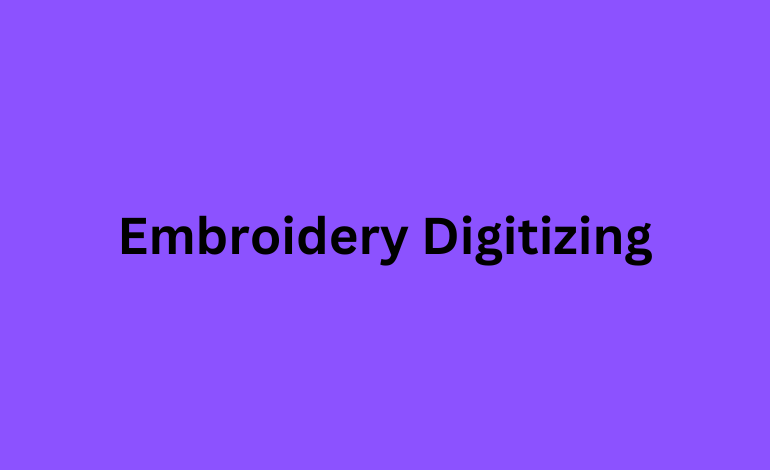Embroidery digitizing is the essential process that turns artwork, logos, and designs into digital files that embroidery machines can understand. This transformation allows your design to be stitched onto fabric with precision, resulting in clean, professional-looking embroidery. Whether you’re creating custom apparel, branded merchandise, or personalized gifts, embroidery digitizing is what brings your vision to life in the thread.
What is Embroidery Digitizing?
Embroidery digitizing is the art of converting a graphic design into a digital embroidery file, usually in formats like DST, PES, or EXP. Unlike regular image files (like PNG or JPEG), embroidery files include instructions for the embroidery machine, detailing the stitch types, directions, thread colors, and stitch density. This ensures that every element of the design—from simple text to intricate patterns—is stitched correctly.
The Embroidery Digitizing Process
- Design Preparation: The first step is to prepare your design for digitizing. Complex designs may need to be simplified, and details adjusted to ensure they look good when embroidered. The design is then imported into specialized digitizing software.
- Digitizing the Design: A digitizer uses software to manually map out every stitch in your design. They choose stitch types (like satin, fill, or running stitches), set the stitch direction, and determine the stitch density. This step is where the digitizer’s expertise really shines, as they balance aesthetics with the technical needs of the embroidery machine.
- Stitch Pathing: The pathing of stitches—the order in which different parts of the design are stitched—is crucial for a smooth embroidery process. Good pathing minimizes thread trims and jumps, ensuring faster production and reducing the risk of errors.
- Test Stitching: Before finalizing the design, a test run is usually done on fabric. This allows for adjustments to be made if the stitches are too dense, too loose, or if there’s any puckering or distortion.
- Final Adjustments and Delivery: Once the test stitch is successful, the file is ready for use. The digitized design can now be consistently reproduced across multiple garments or items, maintaining quality and precision each time.
The Importance of High-Quality Embroidery Digitizing
- Accuracy and Detail: High-quality digitizing ensures that every detail of your design is captured accurately. Whether it’s fine lettering or intricate patterns, good digitizing preserves the integrity of your artwork.
- Professional Results: Well-digitized designs produce clean and polished embroidery. Poor digitizing can result in loose threads, uneven stitching, or designs that don’t resemble the original artwork.
- Versatility: A well-digitized design can be applied to different types of fabrics, from thick jackets to delicate t-shirts. The digitizing process can be customized to suit the specific material, ensuring that the design holds up well across various applications.
- Efficiency: Proper digitizing minimizes thread breaks, machine stops, and errors during production. This not only saves time but also reduces waste and keeps production costs down.
Key Elements of Embroidery Digitizing
- Stitch Types: Different areas of the design require different stitch types. Satin stitches are typically used for borders and outlines, while fill stitches cover larger areas. Running stitches are used for fine details or outlines.
- Stitch Direction and Angle: The direction in which the stitches are laid can impact the overall look of the embroidery, including how light reflects off the thread. A skilled digitizer uses stitch direction creatively to add depth and texture to the design.
- Stitch Density: The number of stitches within a given area is critical to achieving the right balance. Too many stitches can cause fabric puckering, while too few can make the design look sparse or unfinished.
- Compensation: Fabrics can shift or stretch during embroidery, which can distort the design. Compensation techniques adjust the design to account for this movement, ensuring the final product looks exactly as intended.
- Thread Colors and Sequence: The choice and sequence of thread colors are carefully planned to achieve the desired effect. Proper sequencing helps prevent thread bunching and ensures smooth color transitions.
Applications of Embroidery Digitizing
Embroidery digitizing is used in various industries and for numerous purposes:
- Corporate Branding: Logos on uniforms, hats, and promotional items.
- Fashion and Apparel: Custom designs on clothing, caps, bags, and accessories.
- Sports Teams: Team logos, player names, and event commemorations.
- Gifts and Personalization: Monograms, names, and unique designs on towels, blankets, and other items.
- Patches and Badges: Custom patches for organizations, clubs, and events.
Choosing a Professional Embroidery Digitizing Service
When selecting a digitizing service, consider the following factors:
- Experience and Expertise: Look for a service with a strong track record and a portfolio that showcases their range and quality of work.
- Customization Options: The best digitizing services offer customized solutions based on the fabric, design complexity, and intended use of the embroidery.
- Quick Turnaround: Reliable services should provide timely delivery without compromising on quality, especially if you have tight deadlines.
- Customer Support: A good digitizing service should be responsive and willing to make adjustments based on your feedback.
Conclusion: The Art and Science of Embroidery Digitizing
Embroidery digitizing combines creativity with technical skill to bring your designs to life. Whether you’re a business looking to enhance your brand, a fashion designer seeking custom solutions, or someone with a unique embroidery project, high-quality digitizing is essential. It ensures that your designs are translated into beautiful, durable embroidery that looks sharp and professional every time.
Invest in professional embroidery digitizing to make sure your designs look their best—stitch by stitch, every time. Ready to start your project? Get in touch with a trusted digitizing service today!

